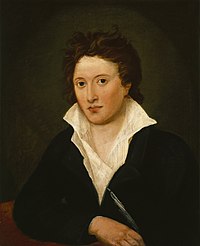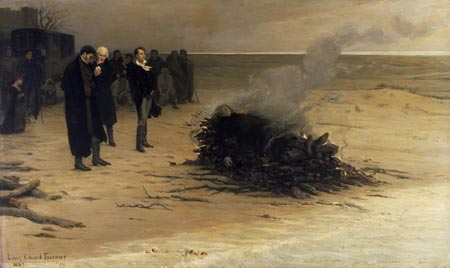|
Percy Bysshe Shelley
( Horsham, England, 1792 - Livorno, Italy, 1822)

(portrait by Amelia Curran, 1819)
Life
Percy Bysshe Shelley was born in a conservative Sussex aristocratic family, but he soon showed his rebellious and anti-dogmatic character. As an Eton pupil, he soon found himself labelled for his early religious scepticism. At the age of nineteen, he was expelled from Oxford as a consequence of the turmoil caused by his pamphlet The Necessity of Atheism; nevertheless, he was able to come in contact with the ideas of the radical philosopher William Godwin.
His sentimental life, as well as his relationship with social and political rules, was very turbulent and problematic: his first marriage with a wealthy Methodist girl gave birth to two children, but was wrecked soon after the couple had returned from Ireland, where they had tried to campaign against British rule. During the years of his relationship with Mary Wollstonecraft Godwin, daughter of his former philosophical master and a writer herself, Shelley moved from Switzerland back to England, then finally abroad again to Pisa, Italy, where he finally settled down with his new family. His private life was saddened by the death of three children and eventually found an end in a sailing accident off the coast of Versilia.

(The Funeral of Percy Bysshe Shelley, by Louis Edouard Fournier)
Main works and stylistic features
Shelley's poetry, as well as his works as an essayist, are deeply influenced by his sincere, though individualistic, commitment to the cause of freedom and equality against all forms of social and political oppression. The strong polarity between the emotional extremes of faith in love and solidarity and calls to political and social upheaval often gives his verse and prose a connotation of emotional excess, and nature often stands as a symbolic image of the poet's inner life.
Shelley's major works are spread over a variety of genres that range over long poems (The Masque of Anarchy, 1819), short poems (Ozymandias, 1818 - To a Skylark, 1820), lyrical drama (Prometheus Unbound, 1820), essay (A Defence of Poetry, 1821). He mastered traditional and contemporary verse forms of English as well as of Italian tradition, from the Spenserian stanza (see Byron) to the couplet, from Dante's terza rima to blank verse.
Sources for this topic:
-
Wikipedia - The Free Encyclopedia: life, works, criticism, resources.
[E1]
[I1]
[F1]
[ES1]
- The Literature Network: biography and free texts.
[E2]
-
The Percy Bysshe Shelley Resource Page: texts and criticism.
[E3]
-
Romanticismo Inglese: biograpical and critical notes on Percy and Mary Shelley for the Italian-speaking reader.
[I2]
 6/15
6/15

|